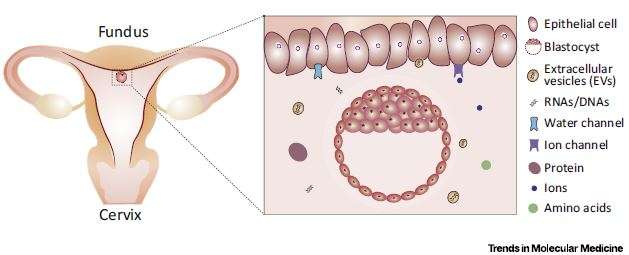The biology of uterine fluid: How it informs the fetus of mom's world

A developing fetus bathes in a mixture of cellular secretions and proteins unique to its mother's uterus. Before fertilization, the pH of uterine fluid helps create a conducive environment for sperm migration, and afterward, its volume supports the embryo as it implants onto the wall of the uterus. Recent evidence suggests that uterine fluid may play another key role in embryonic development: communicating the mother's outside conditions to the fetus, so that the latter can prepare accordingly. A review of this research appears on June 22 in Trends in Molecular Medicine.
Studies in livestock, rodents, and humans have shown that information from a mother's environment (e.g., food availability, stress, and pollutant exposure) can leave epigenetic tags on the DNA of her fetus, potentially influencing the progression and long-term health of the developing embryo. Scientists have hypothesized that blood flow via the placenta might constitute one way the body communicates the mother's condition to the fetus, yet there is evidence that the fetus can react to changes such as those stemming from the mother's diet long before the establishment of the placenta.
"This suggests the involvement of uterine fluid as the communication medium to transfer information between the maternal environment and the floating embryo," says senior author En-Kui Duan, a reproductive biologist at the Institute of Zoology, Chinese Academy of Sciences. "The preimplantation period is a critical time for programming offspring health, and thus, expecting mothers should keep a good diet and good mood, and stay away from harmful chemicals during this critical window."
While there is much to be learned about how mother-fetus communication takes place, the theory is that information in extracellular vesicles (molecular packages that move from cell to cell) within uterine fluid and tissue deliver their cargo, including microRNAs and amino acids, to the fetus. These molecules may be tagging fetal cell DNA in ways that alter which genes are being expressed, and thus can contribute to "programming" how the embryo and/or placenta develop. Consequently, researchers are interested in learning which specific maternal environmental exposures and/or behaviors could change the composition of molecules transported via the uterine fluid to the fetus.
For example, mouse studies have shown that a low-protein maternal diet can reduce the level of certain amino acids in uterine fluid and affect gene expression of nutrition- transport-related genes. While these changes might prevent malnutrition in the developing embryo, once grown, the mouse offspring are more predisposed to heart disease when compared to animals on a regular diet.
Hongmei Wang, co-senior author of this paper, speculates that uterine fluid could someday be used to analyze or even manipulate what signals are being received by a fetus. "For now, uterine fluid collection is not a standard biomarker, yet many studies have revealed its potential role for non-invasive analysis, and we also see great potential in it," she says. "One, it can be screened by using ultrasound recording coupled with computational/biomechanical analysis; and two, uterine fluid can also be collected during an endometrial examination."
More information: Trends in Molecular Medicine, Zhang, Ying et al.: "Uterine Fluid in Pregnancy: A Biological and Clinical Outlook." www.cell.com/trends/molecular- … 1471-4914(17)30080-1 , DOI: 10.1016/j.molmed.2017.05.002


















